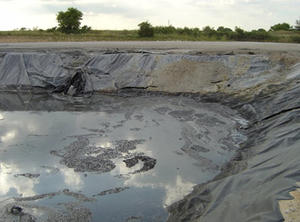The water we drinkRadioactive waste contaminates drinking water, EPA does nothing
Recent Environmental Protection Agency (EPA) documents show that Pennsylvania’s drinking water has been contaminated with radioactive waste from natural gas drilling; energy companies have been extracting natural gas with a new drilling technique called “hydrofracking”; this process results in millions of gallons of wastewater that is contaminated with dangerous chemicals like highly corrosive salts, carcinogens, and radioactive elements; EPA documents reveal the process has been contaminating drinking water supplies across the country with radioactive waste; in Pennsylvania more than 1.3 billion gallons of radioactive wastewater was trucked to plants that could not process out the toxins before it released the water into drinking supplies

Hydrofracking waste pit // Source: wilderness.org
Recent Environmental Protection Agency (EPA) documents show that Pennsylvania’s drinking water has been contaminated with radioactive waste from natural gas drilling.
Energy companies have been extracting natural gas with a new drilling technique called high volume horizontal hydraulic fracturing, or hydrofracking. This technique involves blasting large amounts of highly pressurized water mixed with sand and chemicals at rock formations to break them up and release the gas. This process results in millions of gallons of wastewater that is contaminated with dangerous chemicals like highly corrosive salts, carcinogens, and radioactive elements.
The EPA, state regulators, and drilling companies had known that this process resulted in toxic by-products, but recent EPA documents obtained by the New York Times reveal that the environmental and health risks were far greater than they had anticipated.
The New York Times reports that the documents detail how wastewater is sometimes hauled to water recycling plants that are not designed to process these types of contaminants and the water is discharged into rivers that supply drinking water.
Sewage treatment plant operators admit that they cannot effectively remove radioactive contaminants. As a result some water supplies near natural gas wells now contain radioactivity levels far beyond levels deemed safe by federal regulators.
Drinking supplies in Pennsylvania are at high risk with natural gas drilling nearly doubling in the past ten years. There are currently approximately 71,000 active gas wells, up from roughly 36,000 active wells in 2000.
In the past three years alone, wells in Pennsylvania produced more than 1.3 billion gallons of waste water. The radiation levels of wastewater from these plants have been found to be in some cases thousands of times greater than the maximum federal standard allowed. The majority of this water was trucked to plants that were not equipped to remove the toxins.
John H. Quigley, who served as secretary of Pennsylvania’s Department of Conservation and Natural Resources until last month, said “We’re burning the furniture to heat the house.”
“In shifting away from coal and toward natural gas, we’re trying for cleaner air, but we’re producing massive amounts of toxic wastewater with salts and naturally occurring radioactive materials, and it’s not clear we have a plan for properly handling this waste,” he said.
Pennsylvania is not the only state adversely affected by natural gas drilling. Drilling companies from Pennsylvania trucked their wastewater to processing plants in New York and West Virginia. While in other states including Colorado, Ohio, and Texas, gas has seeped into underground drinking water supplies.
“Hydrofracking impacts associated with health problems as well as widespread air and water contamination have been reported in at least a dozen states,” said Walter Hang, president of Toxics Targeting, a firm that specializes in compiling data on gas drilling.
In 2009 there were nearly 500,000 active gas wells in the United States, nearly twice as many as 1990, and roughly 90 percent of them use hydrofracking to extract gas.
Energy companies have largely been left to regulate themselves in Pennsylvania, reporting their own spills, drafting their own spill response plans, and leading their own cleanup efforts. The Times found that response plans at four Pennsylvania wells that had accidents in the past year were in violation of the law, despite being approved by the state.
Data also shows none of the sixty-five water intake plants downstream from the busiest drilling areas in Pennsylvania have been tested for radioactivity since 2008, and most of the plants in the state have not been tested since at least 2005.
John Hanger, the secretary of the Pennsylvania Department of Environmental Protection until he stepped in January, said, “There are business pressures” on companies to “cut corners.”
“It’s cheaper to dump wastewater than to treat it,” he said.
The amount of radioactive wastewater is projected to increase as more than 50,000 new wells are expected to be drilled over the next twenty years in Pennsylvania.
